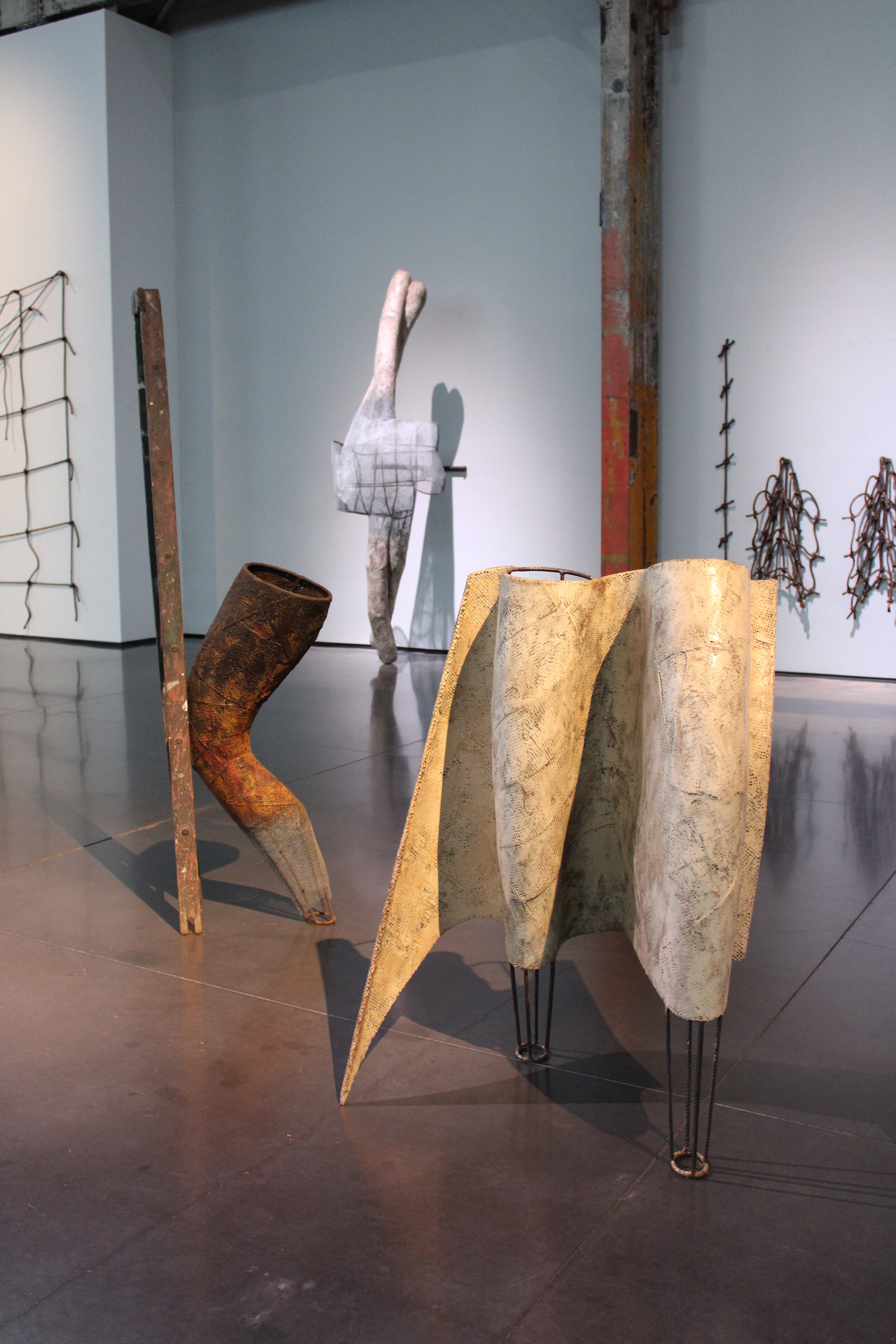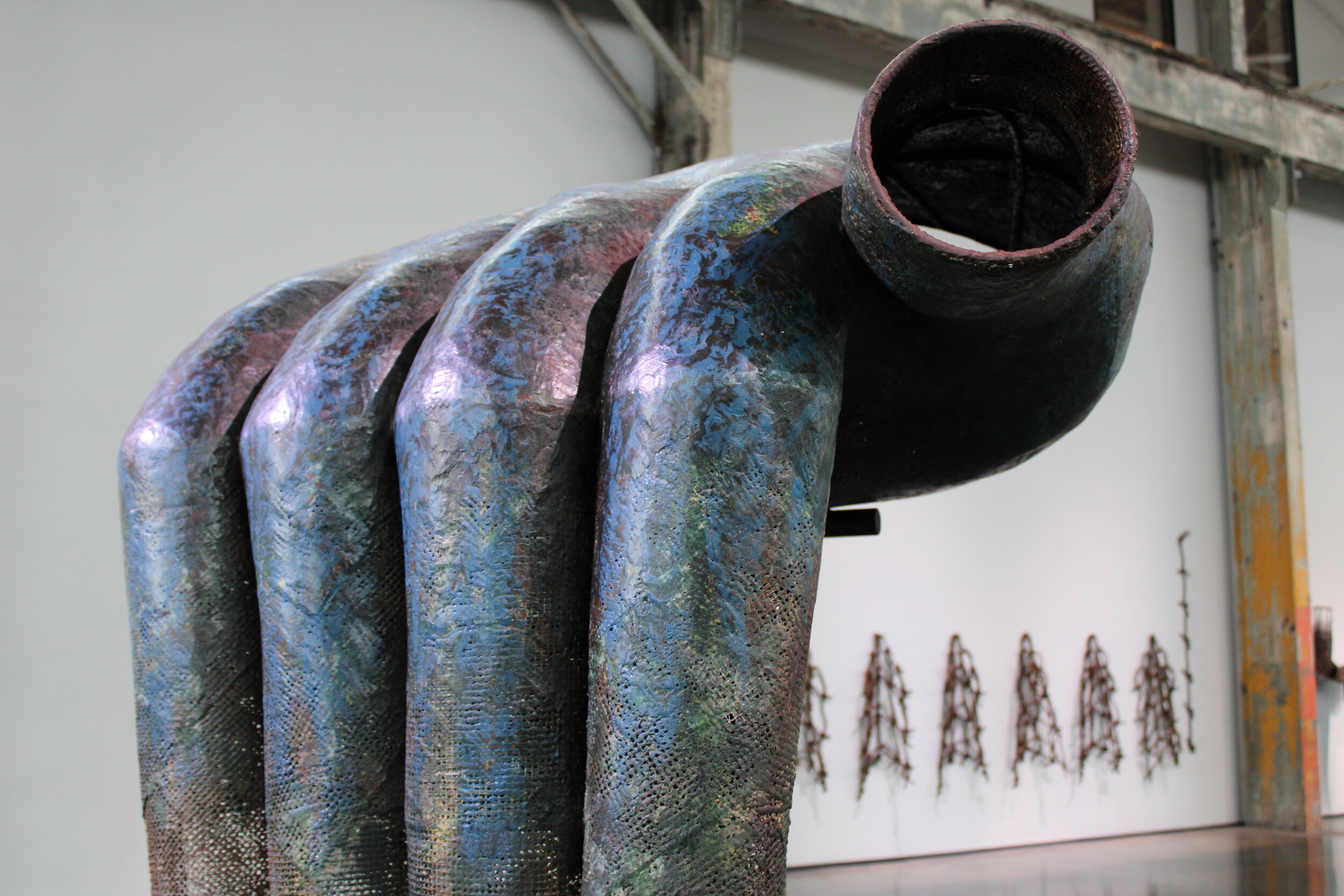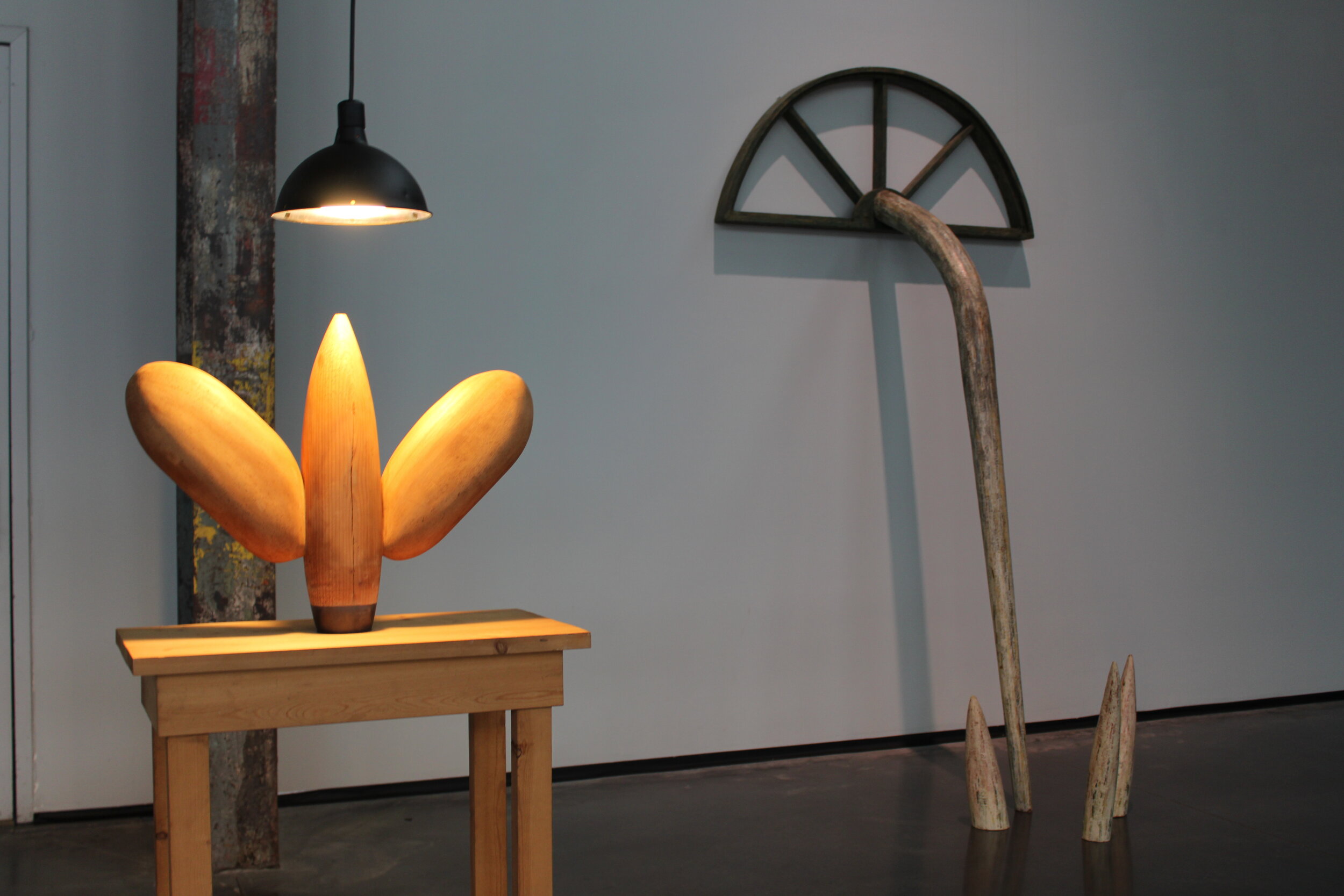It is easy to misread sculpture as a static medium, or as one dedicated to inward-looking stillness. Great art, though, can upend such preconceived notions of its genre. One of the best regarded Baroque sculptures, Bernini’s David, for instance, is known for its remarkable torsion. Building up in the subject’s taut body, the drama inherent in tension and expected release is the key to this great work. In Down to Earth, a career-spanning survey of work by twentieth century sculptor Robert Rohm (1934-2013) another artist’s relationship with notions of tension, balance, and even motion is explored in depth. On view through April 25, 2021, at The WaterFire Arts Center in Providence, it includes selections from a diverse oeuvre created over four decades. A remarkable exhibition, it shows off the artist’s use of quotidien elements to create transcendent sculptural forms.
Down to Earth at The WaterFire Arts Center opens with a kinetic wood sculpture.
Rohm, a longtime professor at The University of Rhode Island, was an maker steeped in craft, an educator with a giving character, and an artist unparalleled in his capacity to examine structure through unassuming materials. Whereas predecessors like Bernini sculpted in marble, Rohm preferred rope, lead, encaustic, wood, and rebar. These components are used and reused, resulting in cohesive ties binding the far flung aesthetics of differing bodies of work.
The earliest objects in the exhibition were produced in the heady days of 1960’s conceptualism. The show opens with a rough hewn kinetic work in wood and moves into Rohm’s notable rope sculptures. The enormous rope work, Untitled May 16th, 1969, engages an entire wall but is constructed of simple Manila rope. Exhibited at The Whitney Museum alongside the likes of Carl Andre and Eva Hesse, the piece consists of a sixteen foot tall by twenty-two foot wide grid of two foot squares. Nailed to the wall, the work is based on the interplay between construction and disruption. When Rohm released several of the identical knots from their nails on the wall, the overwhelming grid began to give way and to dive into the viewer’s space. In Down to Earth, viewers see a reconstruction of this work executed to the exacting standards of the artist. This activation of the artist’s original intent is an essential element of conceptual art.
In later works, Rohm explored familiar figurative forms made up of materials like rebar and encaustic. This series is spookily fleshy and corporeal. In one piece, Untitled (Large Cascade), from 1996, a massive hand balances on a lone finger as its iridescent blue surface disintegrates into the sketchy contours of digits shaped in metal mesh. Hands and fingers are a reappearing motif in this group, as are shapely torsos and mantle-like forms empty of bodies. Limbs flexed and tense, or still and resolute shoulders, or a cupped palm, are all fashioned out of elements which could be procured from the hardware store. Rohm was able to play with material, with form, with the tensions between subject and object, in ways that reward the viewer who takes the time to look closely.
A view of Untitled (Large Cascade) in Down to Earth at The WaterFire Arts Center.
A grouping of tables, described in exhibition text as “Platonic work benches”, shows off Rohm’s taste for material as well as his wry sense of humor. Leaden wheels and sleigh runners serve as feet on two such tables, while another is ankle deep in metal buckets. Overhead, shop lights dangle to illuminate mysterious objects. The whole series is a sampler of sketches in the type of craftsmanship Rohm enjoyed. These benches are strangely personified, totemic, and even altarlike. In one table, the viewer is invited to look through a glass surface into a void below which is shaped in the outline of a basilica or cathedral. Architectural forms undergird crafted objects. The hard lines of this series counterbalance the soft and amorphous edges of other sculptures on view.
Almost a quarter of the space is dedicated to a series of columns, all using rebar in one form or another. In this group, objects within cages seem to defy gravity, with the hand-formed metal canopies being the only thing to stop encaustic balloons from floating away into the cavernous space above them. These works are all about verticality, but also are almost leaden in their weighty footings. They are also largely transparent, with voids between rebar acting as windows onto still other sculptures beyond. Both solid and punctured, they are firmly clung to the ground but aspire to be aloft. The sense of the totemic object found in Rohm’s tables might be noticed here as well, as might a sense of the ceremonial.
Rohm’s production was singular, but while early works correlate to those of co-exhibitors like Andre and Hesse, some later objects reflect the sensitivity for materials more common in a different contemporary like Martin Puryear. Rohm and Puryear overlapped for a period and the warmly tactile quality found in Rohm’s work can also be seen in Puryear’s. Finding such stylistic connections between divergent artists is one of the delights of this exhibition.
Rohm was in command of an array of sculptural techniques, but also made enviable drawings. Throughout the exhibition, there is a smattering of works on paper by the artist which are nearly as obsessively textured as the surfaces of his encaustic-covered forms. Recurring objects like pianos, lightbulbs, or the jagged map of Rhode Island appear in these two dimensional pieces. They are lively and colorful. In two-dimensions, they express the same knack for specificity and exactitude that one sees in the artist’s three-dimensional work.
To close out the exhibition, a separate gallery features stage sets the artist created as well as intricate and beautiful maquettes. Rohm used these as the basis for many of his projects, some of which are on view in the exhibition. These tiny alter egos are so fantastically detailed that they could be mistaken for their full size counterparts. Here, macabre subject matter works itself out. Little gibbeted and dismembered figures that recall Goya are examples of such imagery. In another maquette, a window looks onto a winch, where a coiled rope appears on the verge of snapping. Another small sculpture features an electric chair. The tension in these small works is as intense as that in the full scale objects nearby.
The last gallery of the exhibition is lined with maquettes and features stage sets created by Rohm.
As one exits the show, there is a drawing on view Rohm made in the days before he passed away. In this diminutive work, a forest of brown trees parts to reveal a sliver of sky, which transitions through tones of blue. Depending on how it is read, it could either be a scene of dawn breaking or evening falling. This type of tension or ambiguity is poetic, and beautiful, and is present throughout much of the work on view.
This is a rich and varied exhibition, and one which serves as a necessary primer for Rohm’s significant production over a lifetime. From the 1960’s into the 2000’s, it charts his skillful craftsmanship of core materials and his sensibility for design, balance, and tension in many wonderful forms.
Down to Earth: Robert Rohm Sculpture, 1963-2013 will run March 24 – April 25, 2021. The exhibit is free for all, donations encouraged. The WaterFire Arts Center hours are: Wednesday – Sunday, 10:00 a.m.- 5:00 p.m, Thursday 10:00 a.m. – 8:00 p.m. In following Rhode Island’s COVID-19 protocols, all visitors are required to self-screen before entering the WaterFire Arts Center and practice safety rules: keeping a 6’ distance from others and wear a mask at all times. For more information, visit www.waterfire.org.
Below, explore a slideshow of my photographs of my favorite details from the exhibition.












